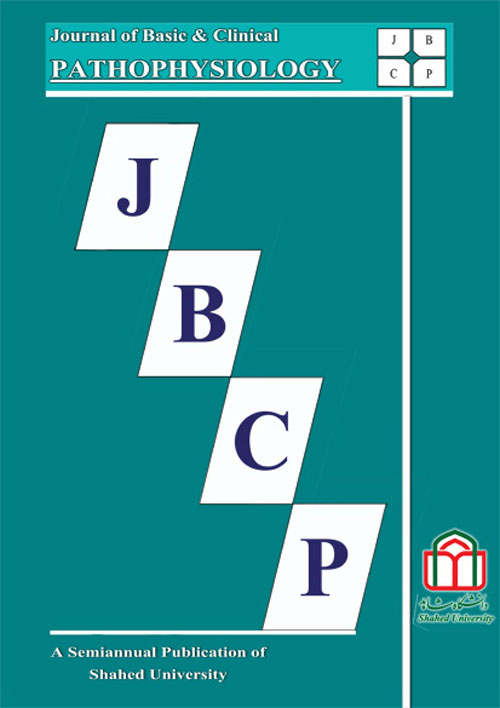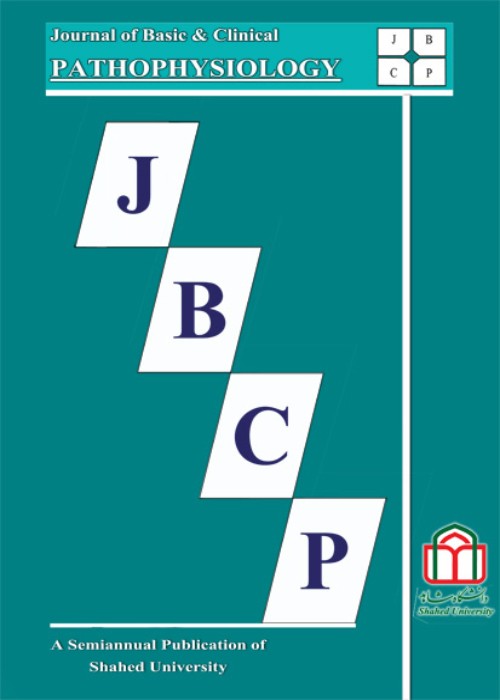فهرست مطالب

Journal of Basic & Clinical Pathophysiology
Volume:10 Issue: 1, Winter-Spring 2022
- تاریخ انتشار: 1401/04/26
- تعداد عناوین: 7
-
-
Pages 1-9Background and ObjectivePolycystic ovary syndrome (PCOS) is a relatively common problem among women of reproductive age. Morphine can disrupt the reproductive axis and cause ovarian cysts. Estrogen can reduce the incidence of benign cysts and ovarian cancer. We investigated the interfering effect of low-dose estrogen on morphine-induced PCOS in rats.Materials and MethodsFemale Wistar rats (weighing 200 to 250 g) were purchased from Pasteur Institute of Iran and adapted to standard conditions in an animal care center. In the diestrous phase, they were randomly divided into four groups: single morphine (5 mg/kg), alone estrogen (0.03, 0. 06 and 0.09 mg/kg), estrogen + morphine, and control (saline, 1 mL/kg). Seventy-two h after injection (i.p.), blood samples were taken from animals under anesthesia to analyze serum factors. After surgery, the uteri and ovaries were examined biometrically, then collected in formalin and examined. Statistical analysis was performed by analysis of variance (ANOVA).ResultsThe ovaries of morphine-treated rats showed polycystic feature, however, the number of cysts was significantly reduced in the presence of estrogen (especially at a very low dose of 0.03 mg/kg). Morphine also reduced LH level, which was improved by co-injection of low-dose estrogen (0.03 mg/kg).ConclusionAdministration of estrogen in low doses may have a protective effect on morphine-induced PCOS in rat.Keywords: Polycystic ovary, Low dose Estrogen, Morphine, Rat
-
Pages 10-16Background and ObjectiveUnderstanding the social, economic, and physical determinants of telomere size is important to assess the risk of early biological aging. In this study, we investigated the association between socioeconomic parameters (marital status, income level, smoking status, and body mass index) and leukocyte telomere length (LTL) in Iranian adults. This cross-sectional study was part of a prospective cohort project in West Azerbaijan province, Iran.Materials and MethodsOne hundred and three adult participants (28-74 years) were included in this study. Personal and health data of each volunteer were obtained through the interview surveys, self-reports and clinical examinations. The LTL of each individual was relatively measured by real-time PCR. The association of relative LTL with socioeconomic status was evaluated after adjusting for age.ResultsThe LTL was inversely correlated with the individual’s age (R=-0.226, P<0.001). The age-adjusted LTL of participants was also positively associated with income level (R=-0.301, P<0.001) while it was not significantly correlated with overall marital, smoking, and body mass index (BMI) statuses. The age-adjusted LTL was increased in higher income levels compared to lower levels (P<0.001). There were no significant differences in the age-adjusted LTL between various variables of marital, smoking, and BMI statuses.ConclusionIn the studied population, the income played a critical role in the telomere size and subsequent biological aging while smoking, marital, and BMI statuses did not have considerable influence on the telomere maintenance.Keywords: Telomere length, Socioeconomic position, Biological aging
-
Pages 17-24Background and ObjectiveIschemia-reperfusion (IR) injury is one of the main pathophysiologic conditions of the testis. Despite free radical scavenging property of the tannins, limit information exists for their antioxidant activity. The aim of this study was to determine the effect of L-theanine administration on testicular I/R injury in the rat.Materials and MethodsThirty male Wistar rats were randomly divided into 5 experimental groups (n=6/group). In I/R group, rats subjected to 4 h I/20 h R period and i.p. injected with saline 1 hour before the R. In groups 3-5, rats subjected to 4 h I/20 h R period and i.p. injected with L-theanine (100, 200 or 400 mg/kg) 1 hour before the R. At the end of the study, left testis was removed for histological analysis and antioxidant measurement.ResultsAccording to the results, I/R leads to degenerated seminiferous tubules and loss of spermatogenesis. Administration of the L-theanine (200 and 400 mg/kg) followed by I/R was associated with many normal seminiferous tubules. Tissue malondialdehyde (MDA) levels significantly increased in I/R rats (P<0.05) while L-theanine decreased I/R-induced MDA (P<0.05). Experimental I/R significantly decreased superoxide dismutase (SOD) and glutathione peroxidase (GPx) activity (P<0.05). Administration of the L-theanine significantly increased tissue activity of SOD and GPx in I/R rat (P<0.05).ConclusionThese findings suggested that treatment with L-theanine has a beneficial effect against I/RKeywords: Ischemia, L-theanine, Reperfusion, Testicular
-
Pages 25-29ObjectiveThe present study was for investigation of the analgesic effect of oral and intraperitoneal (i.p.) administration of alcoholic Viscum album L (V. album) fruit extract as a rich source of alkaloid substances.Materials and MethodsExperimented animals were divided to control and treatment groups. The treatment group received different doses of the extract which was prepared from alcoholic smashed fruits. Then, the animals from each group were subjected to pain scoring experiments such as hot plate and formalin tests.ResultsThe results of the experiments i.e., anti-nociceptive effect of V. album extract in i.p. (50, 100 and 200 mg/kg) and oral application method V. album (6.25% food pellet) were compared with others and morphine sulfate and naloxone as positive and negative control groups, respectively. However, the extract over than 100 mg/kg i.p. could potentially alleviate the pain in hot plate and both phases of formalin test. Besides, there was a marked anti-nociceptive effect of the extract (over than 200 mg/kg) in oral method in hot plate and both phases of formalin tests. In our next experiments, the effective doses of morphine sulfate as the positive control drug were obtained over than 15 mg/kg; i.p.ConclusionIn summary, by comparing the analgesic effect of different doses of morphine sulfate with V. album fruit extract in i.p. and oral conditions and regarding the extract LD50, it is concluded that the V. album fruit extract has a potent, semi-absorbable, and nearly safe ingredient which can exert a potential analgesic effect in acute and chronic pain.Keywords: Viscum album, Formalin test, Hot plate
-
Pages 30-37Background and ObjectiveColchicine depolymerizes microtubules and reduces their diamagnetic capacity. We investigated the effect of a static magnetic field (SMF) and the Fe2O3 NPs on the Paramecium caudatum exposed to colchicine.Materials and MethodsThe samples were collected from temporary water sources and after identifying the species, were cultured in the laboratory. They were also sub-cultured at regular intervals (7-10 days) for purification. From pure culture, several samples were placed in the laboratory or under SMF with an intensity of 61 mT for 3 days. To evaluate the effect of materials in comparison with distilled water (control), a sample (0.1 ml) of each medium was placed on a slide and exposed to 1 μl of distilled water or volume-concentrations of colchicine (0.05 to 25 μg/μl) or Fe2O3 NPs (0.05 to 3 μg/μl). The effect of different concentrations of Fe2O3 NPs in accompany with the field was also investigated. The movement of the animal was examined for 30 sec under a constant view and the sample was fixed for staining and study at the cellular level. Data were analyzed using analysis of variance.ResultsColchicine at high concentrations (15 and 25 μg/μl) significantly reduced the motility of Paramecium caudatum. Magnetic field, but not NPs, alone reduced cell motility. Co-exposure to particles completely improved cell motility due to exposure to colchicine, however, in animals initially housed in the magnetic field, the healing effect of the particles was impaired.ConclusionThe protective effects of NPs may depend on the diamagnetic capacity of the microtubule.Keywords: Paramecium caudatum, Colchicine, Static magnetic field, Fe2O3 nanoparticles
-
Pages 38-44Background and ObjectiveCognitive deficits are associated with neurodegenerative disorders including Alzheimer’s disease (AD). Trimethyltin chloride (TMT) with potent neurotoxicity is used to induce cognitive dysfunction in rodents. Crocin is the main effective component of saffron with anti-oxidant and anti-inflammatory potential. In the present study, we investigated the effect of crocin on TMT-induced cognitive dysfunction.Materials and MethodsTMT was i.p. administered (8 mg/kg, once) and crocin was daily given p.o. 1 h after TMT for 3 weeks at doses of 10 or 50 mg/kg. Cognitive performance was assessed in different behavioral tasks. In addition, hippocampal oxidative stress and apoptosis were measured.ResultsTreatment of TMT-challenged rats with crocin (at a dose of 50 mg/kg) prevented deficits of recognition memory in Y maze, discrimination ability in novel object discrimination (NOD) test and conditional learning and memory index in passive avoidance task. Besides, crocin significantly lowered hippocampal level of ROS and improved activity of superoxide dismutase (SOD) besides ablation of apoptotic factors including caspase 3 activity and DNA fragmentation.ConclusionIn conclusion, crocin administration could ameliorate TMT-induced cognitive dysfunction, in part through targeting hippocampal apoptosis and oxidative stress.Keywords: Crocin, Trimethyltin, Cognition, Neurotoxicity, Oxidative stress
-
Pages 45-49Background and ObjectiveIntracerebroventricular (ICV) injection of streptozotocin (STZ) in rodents causes a model of sporadic Alzheimer's disease (sAD) with development of insulin resistance and neuronal dysfunction. Paeonol is a phenolic agent with neuroprotective effect due to its anti-inflammatory and anti-oxidant effects. This study was conducted to assess its beneficial effect in prevention of brain glucose hypometabolism in ICV STZ rat model of sAD.Materials and MethodsSTZ (3 mg/kg) was bilaterally injected ICV on days 0 and 2 using stereotaxic surgery and paeonol was orally given at two doses of 25 (low) or 100 (high) mg/kg from day 0 (post-surgery) till day 24 post-STZ. At the end of study, positron emission tomography (PET) imaging was employed with a micro-PET scanner through tail vein injection of 18FDG and brain to background ratio (BBR) was calculated.ResultsICV-STZ group had a significantly low BBR compared to sham group. In contrast, ICV-STZ group treated with paeonol at a dose of 100 mg/kg had a significantly higher BBR as compared to ICV-STZ group, clearly indicating attenuation of brain glucose hypometabolism. In addition, paeonol at a dose of 25 mg/kg did not significantly improve BBR in ICV-STZ group.ConclusionIn summary, these results revealed the beneficial dose-dependent effect of paeonol in amelioration of brain glucose hypometabolism in STZ-induced model of sAD.Keywords: Sporadic Alzheimer’s disease, Streptozotocin, Paeonol, Brain glucose hypometabolism, Positron emission tomography


